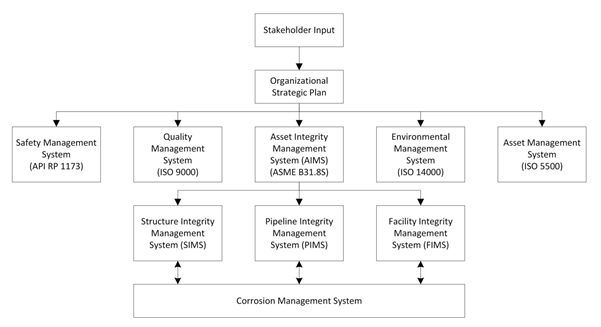General Description
Due to the need to manage the threat of corrosion throughout an asset’s life cycle and by different groups within an organization, a CMS is unlikely to be a standalone management system. More commonly, a CMS takes on the form of components embedded within an existing well-defined management system framework. A CMS should be part of an organization’s asset integrity management system (AIMS) designed to specifically manage the threat of corrosion as well as the other non-corrosion-related threats to the assets or asset systems. For example, the diagram in Figure 3-2 illustrates the interrelation of the various organizational management systems for a pipeline company, into which the CMS is incorporated. These organizational management systems that address important topics such as safety, quality, structural integrity, and environment often already exist within many organizations. For organizations without management systems, creating one would normally have higher priority than implementing a standalone CMS. The applicable standards and recommended practices, which apply to the various management systems, are included in parentheses in the diagram.

Figure 3-2. Interrelation of organizational management systems - pipeline example.

Figure 3-3. Hierarchy of general and corrosion-specific management elements.
Figure 3-3 illustrates the interaction between CMS and other organizational management systems broken out in standard management system elements and the corrosion-specific elements. The diagram shows two major management categories: (i) management system elements that address all threats (including corrosion), and (ii) corrosion-specific elements. The management system elements, at the top of the hierarchy triangle, comprise Policy, Strategies, Objectives and Enablers, Controls, and Measures. The Enablers, Controls, and Measures element contains sub-elements that apply to all management system elements, Including corrosion, such as organization, resources, risk management, training and competency, management review, and continuous improvement (the complete list of these sub-elements is given in the diagram). The corrosion-specific elements address implementation through plans and procedures and working practices.
Figure 3-4 shows how corrosion management fits into the framework of an overall management system through the standard management system elements. The diagram in the figure shows the risk-based corrosion planning process, similar to ISO 31000, Risk Management - Principles and Guidelines, which incorporates threat assessment and prevention or mitigation options. This type of analysis, which fits into the lower two segments of the management triangle, requires an in-depth technical knowledge of the potential or existing corrosion mechanisms and the available options for mitigation. The process can also serve as input to a complete risk-based decision process that includes associated consequences and context, as described later in this section. However, other types of corrosion planning processes may also be utilized depending on the type of industry, regulatory compliance, the required reliability, and ROI considerations.
It is important to note that regardless of the type of corrosion planning process, the personnel, plans, procedures, and work practices are controlled and optimized through the standard management system elements. For example, training and competency of personnel performing corrosion assessments or determining prevention or mitigation options should be defined and consistently applied through the management system. Additionally, communication paths and applicable forms or documentation can be standardized and continuously improved through the management system.
The corrosion management system plans must be communicated to all relevant stakeholders to the level of detail appropriate to their participation or business interests in the delivery of the plans.
The implementation details of the management elements depend on several factors, including:
- The corrosion type observed or expected.
- The life cycle of the asset or asset systems.
- ROI.
- The criticality of the asset or asset systems.
- The applicable regulatory requirements.
- The available mitigation options.

Figure 3-4. CMS Framework (based on ISO 31000).
The final level of the CMS elements (Figure 3-3); i.e., of corrosion-specific processes and documentation, includes the procedures and working practices that result from the corrosion plans. These include the implementation approach, verification, inspection, and mitigation procedures. For example, if re-coating is the mitigation option selected during the corrosion planning process, the associated procedures and work practices may include surface preparation, coating application, and post-coating inspection.
To maximize effectiveness, the CMS must manage the threat of corrosion at each of the significant stages of an asset’s life cycle, from design to decommissioning, as shown in Figure 3-5. Additionally, the CMS’s continual improvement processes allow for review and improvement not only over the life of a specific asset, but also over the life cycles of an organization’s similar assets. In this context, the term “asset” describes individual assets, types of assets, or asset systems that an organization builds, acquires, or enhances.

Figure 3-5. Corrosion management over the life cycle of the asset.